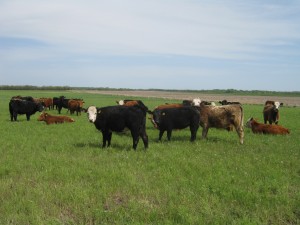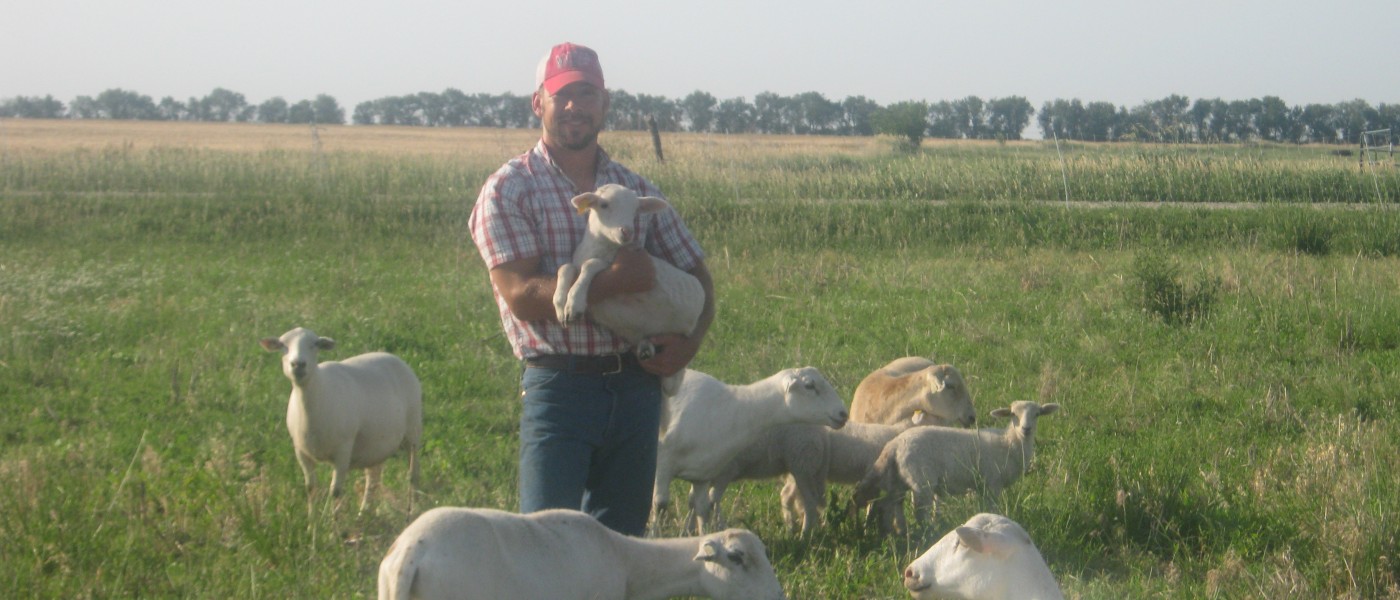Newton, KS
Jason Schmidt is a fifth generation Kansas farmer who raises grass-fed beef and lamb, and works on his family’s dairy farm. After receiving his masters in Plant and Environmental Science and studying farm systems around the world, he recently came back to Kansas to begin farming full time.
Jason Schmidt grew up on his parent’s dairy farm in South Central Kansas, but when he went to college he didn’t think he would ever come back to be a farmer.
After receiving his master’s degree and researching grass and forage based systems, Jason traveled to South Africa, North Korea, Colorado and New Mexico to study a variety of farming systems. His main interest was in international development and sustainable agriculture in developing countries. But he soon recognized, “Farming was a lot more in my blood than I realized.” So Jason moved back to his home community and became a fifth generation farmer.
Jason also began working at the Kansas Rural Center (KRC) as a grazing consultant, organizing educational grazing workshops throughout the state. Jason says, “Working at KRC gave me an excellent opportunity to get to know people around Kansas who have similar ideas to me.” Recently, Jason made the switch to being a full-time farmer. While KRC was sad to see Jason leave, they are glad to have Jason on the land with his innovative ideas for sustainability.
 Jason has recently started his own grass-fed ranching operation and grazes cattle and lamb. This spring, Jason bought 45 yearling Angus cross cattle and he is fattening them (also called “finishing”) to sell them in the fall once they are a minimum of 1050 pounds. Most of Jason’s cattle will be sold to a grass-fed natural beef company,Thousand Hills Cattle, in Minnesota. In addition to his cattle, Jason also has a flock of twenty-five grass-fed Katahdin sheep, a breed of hair sheep that sheds their coat in the summer, making them a good choice for the heat of Kansas. The sheep will be grass-finished and processed in October. Each one is already accounted for, having been pre-sold through direct farmer-to-eater relationships.
Jason has recently started his own grass-fed ranching operation and grazes cattle and lamb. This spring, Jason bought 45 yearling Angus cross cattle and he is fattening them (also called “finishing”) to sell them in the fall once they are a minimum of 1050 pounds. Most of Jason’s cattle will be sold to a grass-fed natural beef company,Thousand Hills Cattle, in Minnesota. In addition to his cattle, Jason also has a flock of twenty-five grass-fed Katahdin sheep, a breed of hair sheep that sheds their coat in the summer, making them a good choice for the heat of Kansas. The sheep will be grass-finished and processed in October. Each one is already accounted for, having been pre-sold through direct farmer-to-eater relationships.
While his wife begins a career in law, Jason is working on a plan for his future as a farmer. Jason is currently working with an organic crop farmer on 350 acres where he grazes legume cover crops and native grass. He also rents 80 acres close to his parents’ land and grows wheat, soybeans and alfalfa. At the moment he is piecing together other pastures to lease for potential future grazing. In the future Jason hopes to eventually convert all of his land to grazing; he says, “I see myself as a grazer, not a crop farmer.” He is also working out whether he wants to be a finishing operation or start his own cow/calf operation. He also dreams of starting an organic, grass-fed dairy, with value-added on farm processing of milk and cheese.
A typical day has Jason awake at 6:30 a.m. to do the morning milking and chores at his parents’ farm, including planting, harvesting and haying. Every other day he then drives 20 miles to where his cattle graze to water and check on his herd. Jason practices rotational grazing and is experimenting with high density grazing, dividing his pasture land into small paddocks using temporary fencing. The idea is to give the cattle the grass and nutrients they need for a few days’ time and then move them on to the next paddock. The grass they’ve just grazed then rests for about 30 days, depending on how dry or wet it is, to absorb the nutrients left behind by the cattle and re-grow. After seeing to his cattle, Jason tends to his sheep. Morning and evening there’s an orphan lamb to be bottle-fed. Jason also continues to work part time at the KRC, organizing an upcoming grazing school.
So, why raise livestock on grass? Jason explains that grass-fed meat has a higher percentage of health promoting fat and cancer-fighting antioxidants and it is much leaner than grain-fed meat. Not only that, grass-fed animals do most of the work themselves—there’s no need to haul manure or purchase feed. Not to mention the soil fertility the pastured animals promote. In Jason’s words, “There is a lot of personal satisfaction from knowing you are producing very healthy products and being a better environmental steward.”
As a new farmer, Jason says there’s a steep learning curve in managing a herd and dealing with challenges like drought. The biggest challenges include gaining access to land and getting the cash flow needed to start up a farm. But Jason suggests that raising a grass-fed herd requires less cash and need for equipment. His advice for new farmers is to be resourceful. Because new farmers don’t have much to start off with, it is helpful to find people to work with or share equipment with.
For many livestock producers wanting to sell into niche markets—natural, organic or grass-fed—the most difficult obstacle is processing. There is a lack of small to mid-size processors because many have been driven out of business by consolidation in the livestock industry. Farmers often have no choice but to ship their animals a long distance; with high fuel prices cutting into their already tight margins. On the other hand, there is growing opportunity for livestock producers to direct market meat and the number of national buyers for grass-fed meat is growing.
As an innovative, sustainable farmer, Jason is focused on “scaling up” and getting sustainable agriculture to the mainstream. As Jason explains, “A major challenge I’ve faced has been coming back to my home community with different ideas.” Nonetheless, Jason has a vision he believes in and he hopes to inspire other farmers with his on-farm practices and through his work at the Kansas Rural Center.
Further Reading
- If you’ve ever wondered why it seems so hard to find meat raised the way you want, you’ll want to take a look at this month’s Ask Farm Aid. It looks into the the powerful corporate players that dictate every detail of how livestock are raised and meat is produced.
- Take a look at Putting it into Practice where we decode the dizzying array of labels on food at the grocery store. Find out which labels you’ll want to actually seek out.



